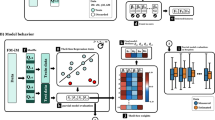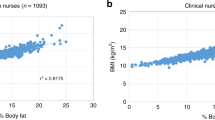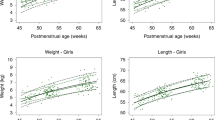Abstract
Background/objectives
Prediction equations generated from anthropometric measures are frequently used to quantify paediatric body composition. We tested the agreeability and predictive power of select (Lingwood and Aris) fat mass prediction equations against body fat measured via ADP; and generated and evaluated new anthropometry-based models for use in the first 6 months of life.
Subjects/methods
Data were obtained from 278 white European Australian infants at birth, 3 and 6 months. Prediction models (i.e. Baby-bod models) were generated for each time point via stepwise linear regression and compared for agreeability with ADP via limits of agreement, mean difference and total bias in Bland–Altman analyses. Predictive power of all equations in comparison to ADP were assessed using linear regression analysis.
Results
Overall, there was poor agreeability between percent body fat predicted via published equations and ADP. Proportional bias was detected for both methods (i.e. published equations and Baby-bod models) of body fat prediction. At birth, both Lingwood and BB0 equations overestimated percent body fat at the lower end of the FM spectrum. This trend was repeated at 3 months with all equations displaying a propensity to overestimate body fat at lower FM levels and underestimate at higher FM levels.
Conclusions
The results indicate that anthropometry, although less costly and relatively easier to implement, does not always produce comparable results with objective measures such as ADP. Given the importance of the accurate assessment of physical growth, including body composition in early life, it is timely to recommend the increased utilisation of techniques such as ADP.
This is a preview of subscription content, access via your institution
Access options
Subscribe to this journal
Receive 12 print issues and online access
$259.00 per year
only $21.58 per issue
Buy this article
- Purchase on Springer Link
- Instant access to full article PDF
Prices may be subject to local taxes which are calculated during checkout



Similar content being viewed by others
References
Yao M, Nommsen-Rivers L, Dewey K, Urlando A. Preliminary evaluation of a new pediatric air displacement plethysmograph for body composition assessment in infants. Acta Diabetol. 2003;40:s55–s58.
Urlando A, Dempster P, Aitkens S. A new air displacement plethysmograph for the measurement of body composition in infants. Pediatr Res. 2003;53:486.
Evaluation of body composition in neonates and infants. Seminars in Fetal and Neonatal Medicine. Elsevier, 2007.
Aris IM, Soh SE, Tint MT, Liang S, Chinnadurai A, Saw SM, et al. Effect of maternal glycemia on neonatal adiposity in a multiethnic Asian birth cohort. J Clin Endocrinol Metab. 2014;99:240–7.
Brunner S, Schmid D, Hüttinger K, Much D, Heimberg E, Sedlmeier EM, et al. Maternal insulin resistance, triglycerides and cord blood insulin in relation to post‐natal weight trajectories and body composition in the offspring up to 2 years. Diabet Med. 2013;30:1500–7.
Cauble JS, Dewi M, Hull HR. Validity of anthropometric equations to estimate infant fat mass at birth and in early infancy. BMC Pediatr. 2017;17:88.
Catalano PM, Mele L, Landon MB, Ramin SM, Reddy UM, Casey B, et al. Inadequate weight gain in overweight and obese pregnant women: what is the effect on fetal growth? Am J Obstet Gynecol. 2014;211:137. e131–137.
Hauner H, Much D, Vollhardt C, Brunner S, Schmid D, Sedlmeier E-M, et al. Effect of reducing the n−6: n−3 long-chain PUFA ratio during pregnancy and lactation on infant adipose tissue growth within the first year of life: an open-label randomized controlled trial. Am J Clin Nutr. 2011;95:383–94.
Badon SE, Dyer AR, Josefson JL, Group HSCR. Gestational weight gain and neonatal adiposity in the hyperglycemia and adverse pregnancy outcome study-North American region. Obesity. 2014;22:1731–8.
Kulkarni B, Mamidi R, Balakrishna N, Radhakrishna K. Body composition assessment in infancy and early childhood: comparison of anthropometry with dual-energy X-ray absorptiometry in low-income group children from India. Eur J Clin Nutr. 2014;68:658.
Lingwood BE, van Leeuwen A-MS, Carberry AE, Fitzgerald EC, Callaway LK, Colditz PB, et al. Prediction of fat-free mass and percentage of body fat in neonates using bioelectrical impedance analysis and anthropometric measures: validation against the PEA POD. Br J Nutr. 2012;107:1545–52.
Hussain Z, Jafar T, uz Zaman M, Parveen R, Saeed F. Correlations of skin fold thickness and validation of prediction equations using DEXA as the gold standard for estimation of body fat composition in Pakistani children. BMJ Open. 2014;4:e004194.
Peñalvo JL, Santos-Beneit G, Sotos-Prieto M, Martínez R, Rodríguez C, Franco M, et al. A cluster randomized trial to evaluate the efficacy of a school-based behavioral intervention for health promotion among children aged 3 to 5. BMC Public Health. 2013;13:656.
Röttger K, Grimminger E, Kreuser F, Assländer L, Gollhofer A, Korsten–Reck U. Physical activity in different preschool settings: an exploratory study. J Obes. 2014;2014:196–204.
Dauncey M, Gandy G, Gairdner D. Assessment of total body fat in infancy from skinfold thickness measurements. Arch Dis Child. 1977;52:223–7.
Catalano PM, Thomas AJ, Avallone DA, Amini SB. Anthropometric estimation of neonatal body composition. Am J Obstet Gynecol. 1995;173:1176–81.
Deierlein AL, Thornton J, Hull H, Paley C, Gallagher D. An anthropometric model to estimate neonatal fat mass using air displacement plethysmography. Nutr Metab. 2012;9:21.
Slaughter MH, Lohman TG, Boileau R, Horswill C, Stillman R, Van Loan M, et al. Skinfold equations for estimation of body fatness in children and youth. Hum Biol. 1988;60:709–23.
Aris I, Soh S, Tint M, Liang S, Chinnadurai A, Saw S, et al. Body fat in Singaporean infants: development of body fat prediction equations in Asian newborns. Eur J Clin Nutr. 2013;67:922.
de Onis M, Onyango AW, Van den Broeck J, Chumlea WC, Martorell R. Measurement and standardization protocols for anthropometry used in the construction of a new international growth reference. Food Nutr Bull. 2004;25:S27–S36.
Fomon SJ, Haschke F, Ziegler EE, Nelson SE. Body composition of reference children from birth to age 10 years. Am J Clin Nutr. 1982;35:1169–75.
Giavarina D. Understanding bland altman analysis. Biochem Med. 2015;25:141–51.
Hawkes CP, Hourihane JOB, Kenny LC, Irvine AD, Kiely M, Murray DM. Gender-and gestational age–specific body fat percentage at birth. Pediatrics. 2011;128:e645–651.
Huvanandana J, Carberry AE, Turner RM, Bek EJ, Raynes-Greenow CH, McEwan AL, et al. An anthropometric approach to characterising neonatal morbidity and body composition, using air displacement plethysmography as a criterion method. PLoS ONE. 2018;13:e0195193.
Weststrate JA, Deurenberg P. Body composition in children: proposal for a method for calculating body fat percentage from total body density or skinfold-thickness measurements. Am J Clin Nutr. 1989;50:1104–15.
Davies PS, Lucas A. The prediction of total body fatness in early infancy. Early Hum Dev. 1990;21:193–8.
Yajnik CS, Fall C, Coyaji KJ, Hirve S, Rao S, Barker D, et al. Neonatal anthropometry: the thin–fat Indian baby. The Pune maternal nutrition study. Int J Obes. 2003;27:173.
Sainz RD, Urlando A. Evaluation of a new pediatric air-displacement plethysmograph for body-composition assessment by means of chemical analysis of bovine tissue phantoms. Am J Clin Nutr. 2003;77:364–70.
Ma G, Yao M, Liu Y, Lin A, Zou H, Urlando A, et al. Validation of a new pediatric air-displacement plethysmograph for assessing body composition in infants. Am J Clin Nutr. 2004;79:653–60.
Frondas-Chauty A, Louveau I, Le Huërou-Luron I, Rozé J-C, Darmaun D. Air-displacement plethysmography for determining body composition in neonates: validation using live piglets. Pediatr Res. 2012;72:26.
Ellis KJ, Yao M, Shypailo RJ, Urlando A, Wong WW, Heird WC. Body-composition assessment in infancy: air-displacement plethysmography compared with a reference 4-compartment model. Am J Clin Nutr. 2007;85:90–95.
Fields DA, Demerath EW, Pietrobelli A, Chandler‐Laney PC. Body composition at 6 months of life: comparison of air displacement plethysmography and dual-energy X‐ray absorptiometry. Obesity. 2012;20:2302–6.
Dewey KG. Growth characteristics of breast-fed compared to formula-fed infants. Neonatology. 1998;74:94–105.
Gale C, Logan KM, Santhakumaran S, Parkinson JR, Hyde MJ, Modi N. Effect of breastfeeding compared with formula feeding on infant body composition: a systematic review and meta-analysis. Am J Clin Nutr. 2012;95:656–69.
Gridneva Z, Rea A, Hepworth AR, Ward LC, Lai CT, Hartmann PE, et al. Relationships between breastfeeding patterns and maternal and infant body composition over the first 12 months of lactation. Nutrients. 2018;10. https://doi.org/10.3390/nu10010045
Bell KA, Wagner CL, Feldman HA, Shypailo RJ, Belfort MB. Associations of infant feeding with trajectories of body composition and growth. Am J Clin Nutr. 2017;106:491–8. https://doi.org/10.3945/ajcn.116.151126.
Catalano PM, Drago NM, Amini SB. Factors affecting fetal growth and body composition. Am J Obstet Gynecol. 1995;172:1459–63.
Guihard‐Costa AM, Papiernik E, Kolb S. Maternal predictors of subcutaneous fat in the term newborn. Acta Paediatr. 2004;93:346–9.
Acknowledgements
We thank Dr. Steve Street and Anne Hanley for co-managing the project, University of Tasmania/Launceston General Hospital research staff for assistance in the collection of data, Launceston General Hospital midwifery team for assisting recruitment of participants and the Clifford Craig Foundation for providing space for testing/ housing of research equipment. This work was supported, in part, by the International Atomic Energy Agency (CRP E43028 Contract Number 20880), the Bill & Melinda Gates Foundation (OPP1143641) and St.LukesHealth.
Author information
Authors and Affiliations
Contributions
APH, NMB and KA—conceptualisation/design of the study, review and editing of the manuscript. SJ and APH—formulating research questions, writing and editing drafts, data collection/analysis. JB—review and editing of manuscript drafts. MPH—data collection, review and editing of manuscript drafts.
Corresponding author
Ethics declarations
Conflict of interest
The authors declare that they have no conflict of interest.
Additional information
Publisher’s note Springer Nature remains neutral with regard to jurisdictional claims in published maps and institutional affiliations.
Rights and permissions
About this article
Cite this article
Jayasinghe, S., Herath, M.P., Beckett, J.M. et al. Anthropometry-based prediction of body fat in infants from birth to 6 months: the Baby-bod study. Eur J Clin Nutr 75, 715–723 (2021). https://doi.org/10.1038/s41430-020-00768-3
Received:
Revised:
Accepted:
Published:
Issue Date:
DOI: https://doi.org/10.1038/s41430-020-00768-3
This article is cited by
-
How did the use of the social marketing approach in Egyptian communities succeed in improving breastfeeding practices and infants’ growth?
BMC Public Health (2024)
-
Development and validation of anthropometric-based fat-mass prediction equations using air displacement plethysmography in Mexican infants
European Journal of Clinical Nutrition (2023)



